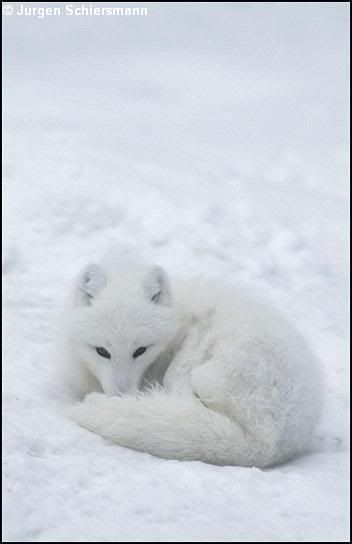
I love foxes!!!!!!!!!!!!!!!!!! But my favorite is the Artic Fox considering that they sometimes turn blue but are originally white. (happen to be two of my favorite colors)
Arctic fox, also known as the polar fox, is a small fox native to cold Arctic regions of the Northern Hemisphere. It is common in all three tundra biomes. Although some authorities have suggested placing it in the genus Vulpes, it has long been considered the sole member of the genus Alopex. The Arctic fox has smaller, more rounded ears, a more rounded braincase, and a slightly shorter and broader muzzle than the red fox, Vulpes vulpes (Clutton-Brock et al. 1976). Its feet are furrier than those of other foxes. The Arctic fox occurs in two distinct colour morphs, "blue" and "white". Each colour phase also changes seasonally: "blue" moults from chocolate brown in summer to lighter brown tinged with a blue sheen in winter, and "white" is almost pure white in winter, and in summer grey to brownish-grey dorsally, and light grey to white below. Colour morphs are determined genetically at a single locus, white being recessive. The "blue" morph comprises less than 1% of the population through most of its continental range, but this proportion increases westwards in Alaska, and on islands. In Greenland roughly half of Arctic foxes are of the blue morph, and in Iceland most of them are blue.
The Arctic fox has evolved to live in the most frigid extremes on the planet. Among its adaptations for cold survival are its deep, thick fur, a system of countercurrent heat exchange in the circulation of paws to keep them from freezing, and a good supply of body fat. The fox has a low surface-area-to-volume ratio as evidenced by its generally rounded body shape, short muzzle and legs, and short, thick ears. Since less of its surface area is exposed to the cold, less heat escapes the body. Its furry paws allow it to walk on ice flows in search of food. It is also able to walk on top of snow and listen for the movements of prey underneath. It has the warmest fur of any mammal.
Arctic foxes mate in early March to early April. The gestation period is 52 days. Litters tend to average seven pups but may be as many as fifteen. Both the mother and the father help to raise their young. The males leave the family and form their own groups and the females stay with the family.
Arctic foxes will eat pretty much anything. Their prey includes voles, lemmings, hares, ground squirrels, and bird eggs. Foxes living on the coast also eat shellfish, sea urchins, dead seals and fish, beached whales, and nesting seabirds. In winter when food is scarce, they may follow a polar bear and after the bear makes a kill, eats and leaves, they will steal what ever scraps of meat are left. In winter, their light coat protects them from predators, esp. polar bears, by blending in to the white snow.
Head-and-body length: 55 cm (21.7 in) (male); 53 cm (21 in) (female).
Tail length: 31 cm (12.2 in) (male); 30 cm (11.8 in) (female)
Shoulder height: 25-30 cm (9.9-11.8 in).
Weight: 3.8 kg (8.2 lb) (male); 3.1 kg (6.7 lb) (female).


